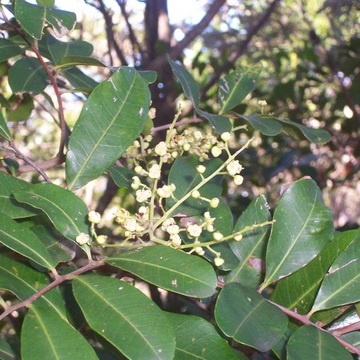Shrubs or small to medium sized, often unbranched palmoid trees ('Schopfbäume'). Twigs terete, smooth to striate or grooved. Indumentum of simple solitary hairs, sometimes mixed with red clávate glands, in many Pacific species mainly consisting of scale hairs. Leaves spirally arranged, paripinnate, 1-28-jugate; pseudo-stipules absent; petiole pulvinate; petiolules pulvinate, usually distinct. Leaflets opposite to alternate, lower ones usually smaller than the upper ones, thinly papyraceous to coriaceous, often punctate; margin entire to serrate or dentate, rarely lobed; upper surface often darker and shinier than the lower, lower surface rarely papillate; domatia absent or present. Inflorescences thyrsoid, axillary, often together pseudoterminal, branched or not, laxly to densely flowered; cymules dichasial, 1-to several-flowered; bracts and bracteoles acicular to deltoid, usually not persisting. Flower buds (flattened) globose to obovoid; flowers regular, unisexual, rarely bisexual, male flowers with a minute pistillode, female ones with rather large staminodes, otherwise not much different. Sepals (4 or) 5(-7), outer 2 distinctly smaller than inner 3, free, imbricate, often concave, especially the inner sepals with a narrow to wide petaloid rim to almost totally petaloid, usually persisting, margin usually ciliate and often also with small glandular hairs. Petals 5, elliptic to orbicular or spathu-late, rhomboid or obovate, rarely clawed, often dentate at apex; scales 1 or 2, rarely crested, free or up to ¾ connate with the margin of the petals, rarely auricles instead of scales. Disc entire, lobed. Stamens (5-)8-14, usually exserted in male flowers; filaments patently hairy, usually up to halfway, rarely glabrous; anthers shorter to longer than the filaments, glabrous to rather densely hairy. Ovary 2-or 3-locular, smooth, glabrous to densely hirsute, sessile or with a short gynophore; style apical, shorter than the ovary, with 2 or 3 stigmatic lines, rarely stigma lobed. Ovules 1 per locule;. Fruit a loculicidal capsule, rarely distinctly lobed, (1-) 2-or 3-celled, sessile or with a short stipe, usually rounded in cross section, rarely keeled; pericarp coriaceous to woody, thin to rather thick, outside smooth to rugose, glabrous to hirsute, inside glabrous to tomentose or appressed-hairy. Seeds ellipsoid or globose to obovoid, often dorso-ventrally, rarely laterally flattened, arillode half to completely covering the seed, rarely (C platycarpa) a sarcotesta, hilum oval, (sub)basal; sclerotesta woody, thin, usually black, endotesta membranous, brownish.
More
Monoecious or dioecious trees. Branchlets lenticellate, indumentum of simple hairs. Leaves paripinnate; leaflets opposite or alternate, with lamina entire to serrate. Inflorescences axillary, raceme-like or panicle-like. Flowers regular, small. Calyx 5-lobed, lobes 2-seriate, imbricate, outer lobes smaller, suborbicular or elliptic, concave. Petals 5, sessile; scales 2, oblong, hairy, crestless. Disc annular, crenate. Stamens 6–10; filaments filiform, pilose in lower half; anthers glabrous. Ovary usually 3-locular; ovule 1 per locule; style short, persistent. Fruit obovoid to subglobose, usually cuspidate, 3-lobed, 3-locular, loculicidally dehiscent; valves slightly fleshy, villous inside. Seed ellipsoidal; aril thin, cupular with erose margin, usually nearly enclosing seed.

